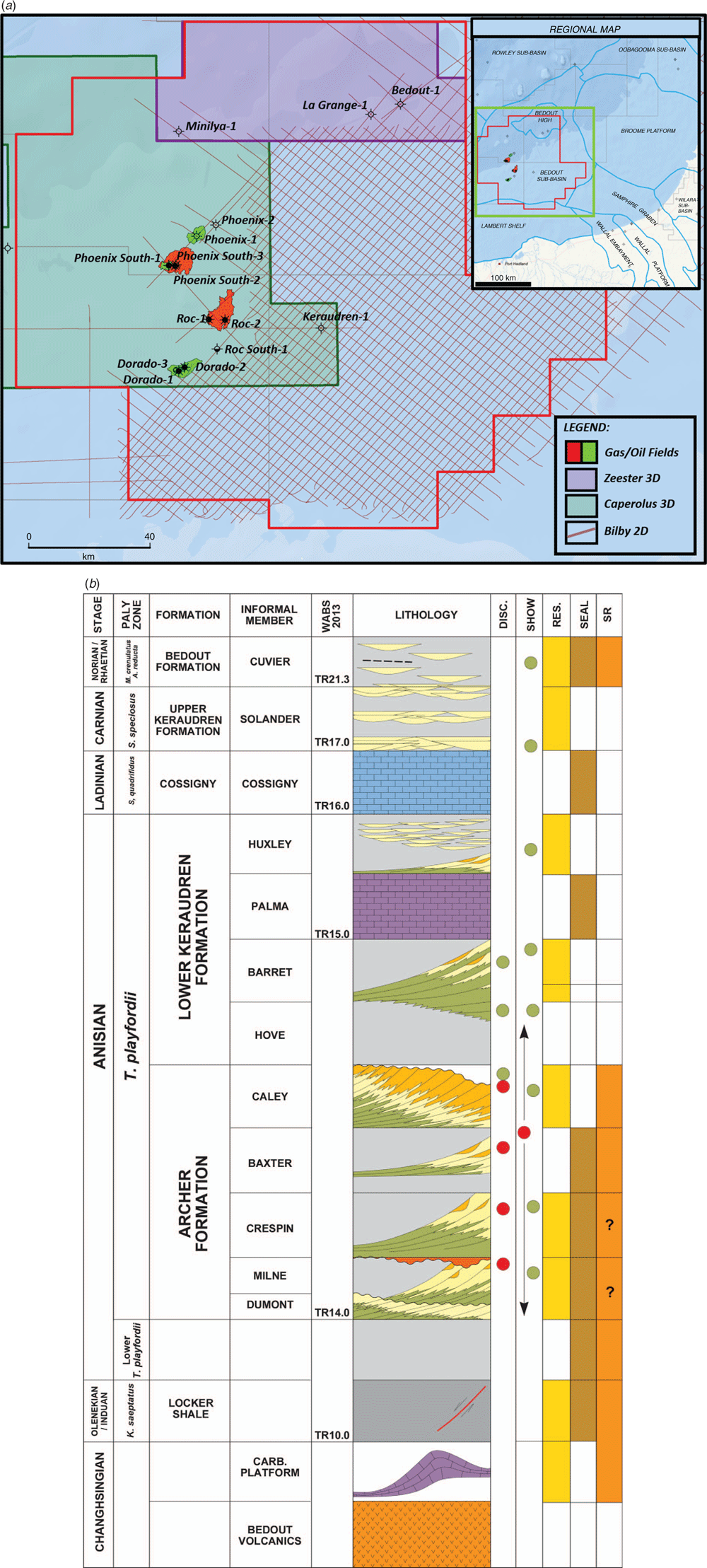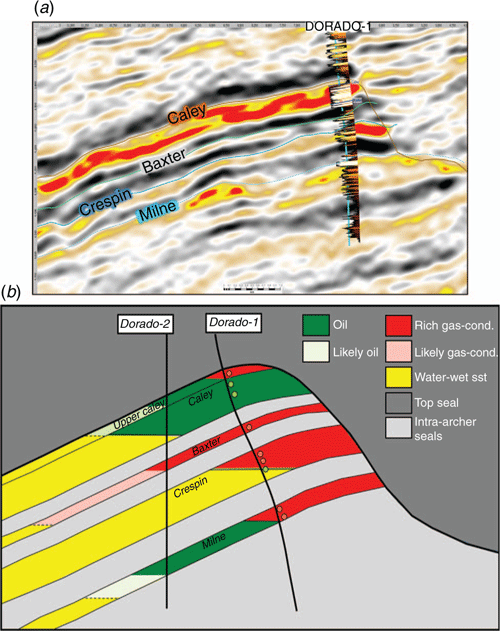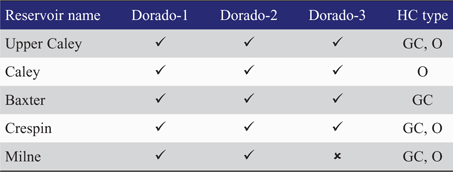Dorado discovery – unlocking a major new oil and gas play in the Bedout Sub-basin
Melissa ThompsonSantos Limited, Level 7, 100 St Georges Terrace, Perth, WA 6000, Australia. Email: melissa.thompson@santos.com
The APPEA Journal 60(2) 778-783 https://doi.org/10.1071/AJ19128
Accepted: 4 April 2020 Published: 15 May 2020
Abstract
In 2014, Santos (formerly Apache and Quadrant Energy Limited) acquired an operated exploration position over most of the under-explored Bedout Sub-basin. A multi-year exploration program was subsequently executed, targeting plays within Middle Triassic fluvio-deltaic sediments of the Lower Keraudren and Archer formations. Initial wells at Phoenix South and Roc established the presence of high-quality reservoirs, source rocks and hydrocarbon fluids, but the commerciality of these discoveries was impeded by the lack of existing production infrastructure in this frontier basin. In 2018, Santos and its Joint Venture partner, Carnarvon Petroleum, drilled Dorado-1, targeting stacked Archer Formation reservoirs in an erosional truncation trap set up by a major canyon system. The well encountered light oil and/or condensate rich gas in high-quality reservoir sands at each of the target intervals. Despite limited well control, burial depths on the order of 4000 m and imperfect seismic data, the pre-drill prognosis was remarkably accurate, largely due to the application of modern seismic inversion techniques. Subsequent appraisal drilling undertaken during 2019 demonstrated the discovery is larger than originally anticipated and has significantly de-risked a future development. New seismic acquired during 2019 will be used to further improve the understanding of Dorado reservoirs and to mature follow-up prospects for future drilling.
Keywords: Archer Formation, Baxter Member, Caley Member, Crespin Member, Lower Keraudren Formation, Milne Member.
Introduction
The Bedout Sub-basin is situated in the south-east of the Roebuck Basin. Located between the Northern Carnarvon Basin to the south and west, the Browse Basin to the north and the onshore Canning Basin to the east (Fig. 1a), it is a relatively under-explored area of the North West Shelf (NWS).

|
Early exploration in the area (1971–1982) saw six wells drilled and resulted in the Phoenix-1 (BP 1980) discovery in the Middle Triassic Lower Keraudren Formation (Fig. 1b) (Wehr et al. 2015; Thompson et al. 2018). Following a period of low activity from the mid 1980s to the 2000s, the recent phase of exploration activity (2012–2019) has resulted in the drilling of a further nine wells and several oil and gas discoveries (Thompson et al. 2015, 2018). These wells targeted plays within Middle Triassic fluvio-deltaic sediments of the Lower Keraudren and Archer formations (Fig. 1b) (Woodward et al. 2018; Thompson et al. 2019). Initial wells at Phoenix South-1 (Apache 2014) and Roc-1 (Quadrant Energy Ltd 2015) established the presence of high-quality reservoirs, source rocks and hydrocarbon fluids. Reservoir productivity was confirmed with the Roc-2 (Quadrant Energy Ltd 2016) drill stem test (DST) that flowed condensate rich gas from the Caley Member at a rate of 55 MMscf/day (Woodward et al. 2018). However, the main impediments to commerciality of these early discoveries were a lack of existing production infrastructure and the remote location of this frontier basin.
The discovery of stacked oil and rich gas-condensate bearing reservoirs within the Archer Formation in Dorado-1 (Quadrant Energy Ltd 2018) has unlocked a major new oil and gas play and is expected to result in the installation of production infrastructure that will support future growth in the basin.
Dorado discovery
Prospect maturation
The Dorado prospect, located 20 km south of the Roc-1 and Roc-2 wells and 145 km north of Port Hedland, was first recognised in 2015, just before the drilling of Roc-1. The prospect is a combination structural/stratigraphic trap, created by the significant Middle Triassic Caley Unconformity incision into the Archer Formation reservoirs and the subsequent fill of the incision topography with sealing lithologies of the Hove Member of the Lower Keraudren Formation (Fig. 1b) (Minken et al. 2019).
The key workflows used to define the Dorado trend prospectivity are outlined below.
3D seismic coverage
The Caley Unconformity is recognised on seismic data as generally coincident with the top of the Caley Member, the youngest unit in the Archer Formation. However, it is also associated with the development of large entrenched valleys (Minken et al. 2018). The northern-most of these valleys sets up a series of culminations on its northern flank, with Dorado the largest of these culminations. While there were some hints of significant incisions within the Middle and Lower Triassic on vintage 2D seismic data, it was not until a large 3D seismic survey (Capreolus MC3D) was acquired in 2015 that the extent of the incised valley system became apparent and closures were mapped.
Seismic inversion
Key pre-drill uncertainties for the Dorado prospect associated with seal and reservoir presence were investigated through quantitative interpretation (QI) workflows. QI has proven to be a valuable tool for both interpretation and well planning in the Bedout Sub-basin (Kongawoin et al. 2019).
For the Dorado trap to be effective, the valley fill lithology was required to provide a seal over a large lateral and vertical extent. Draping the irregular surface of the Caley Unconformity is the regionally continuous, fine-grained Hove Member, the oldest member of the Lower Keraudren Formation (Woodward et al. 2018), which provides a top and lateral seal to the Roc and Phoenix South discoveries. Prior to Dorado-1, it was uncertain whether the trap was compromised by the development of arenaceous beds within the fill. Investigation of seismic inversion vintages predicted the channel infill to be fine-grained, although thief zones below data resolution could not be discounted.
The potential for stacked reservoirs beneath the Caley Member was also addressed by the inversion studies. Encouragement to explore for deeper Archer Formation reservoirs was based on the results of the Roc-1 and Roc-2 wells, with strong hydrocarbon indications encountered in poorly developed argillaceous Crespin and Milne units (Fig. 1b). The inversion results supported the interpretation that the Archer Formation consists of a series of progradational packages, which moved basinward over time, with a series of high probability stacked sand units interbedded with shale units (Fig. 2a), indicating the potential for discreet top seals.

|
Chemostratigraphy
The rapid sedimentation in the Bedout Sub-basin during the Triassic creates challenges for the use of biostratigraphy in well correlations. This is particularly evident for the Middle Triassic T. playfordii palynozone, which covers both the Lower Keraudren and Archer formations (Woodward et al. 2018; Thompson et al. 2019). The use of chemostratigraphy has assisted with developing detailed correlations within the T. playfordii zone, which has allowed higher confidence associations to be made to support reservoir presence and quality prediction. This was important for the prediction of deeper Archer Formation reservoirs at the Dorado prospect, with chemostratigraphic correlations made between the condensed, good quality shelfal facies reservoir units seen in this zone in the Keraudren-1 (Hematite Petroleum 1973) well to the east of Dorado and the more distal, poor quality reservoir deposits encountered in the Roc-1 and Roc-2 wells to the north.
Dorado-1 results
Dorado-1 reached a total depth of 4639.0 m (measured depth rotary table) (–4553.7 m true vertical depth Australian Height Datum) in the Archer Formation in July 2018. The well intersected five separate hydrocarbon bearing reservoirs (Upper Caley, Caley, Baxter, Crespin and Milne) (Fig. 2b and Table 1). The pre-drill prognosis was remarkably accurate, with the top Caley intersected close to the predicted depth and the postulated presence of good quality reservoir sands in the Crespin and Milne Members borne out by the well results. An additional previously unknown hydrocarbon bearing sand was also encountered at the Baxter level, between the Caley and Crespin reservoirs.

|
In Dorado-1, a hydrocarbon-water contact was only intersected within the Crespin. All other reservoirs had hydrocarbon-down-to a base seal, requiring aquifer pressure data from the Caley in the Roc Field to be utilised to estimate potential column heights. The hydrocarbons phase within each of the pools was initially estimated optically down-hole, with all reservoirs, apart from the Baxter (gas-condensate), initially interpreted to contain oil. However, later pressure-volume-temperature analysis confirmed the Caley contained oil, while the fluids sampled from the Upper Caley and Milne are near the transition from oil to gas-condensate in the ‘near-critical’ range, and rich gas-condensate was encountered in the remaining Crespin reservoir.
The reservoir quality encountered in all units at Dorado-1 exceeded expectations, although it was anticipated that improvements were likely due to a ~400 m decrease in burial and a more proximal position than the Roc wells. The presence of intra-formational seals was confirmed; however, the thickness of the sealing facies were much thinner than expected.
Appraisal
As contacts had not been intersected in most of the reservoirs in Dorado-1, the lateral extent and column heights of the hydrocarbon pools were key uncertainties at the start of the appraisal campaign. The incomplete datasets translated into broad resource ranges, with the highest uncertainty attributed to the new reservoirs, particularly the Baxter Member, which had only one penetration in the entire basin.
The highly successful two well appraisal campaign undertaken during 2019 largely addressed these uncertainties through acquisition of full-bore core across the key reservoirs for depositional environment and reservoir development studies as well as comprehensive pressure and fluid sample collection and DST to confirm productivity and reservoir connectivity. Dorado-2 substantially reduced uncertainty in fluids, contacts and reservoir variability and resulted in a material increase in contingent resources relative to the previous estimate at the end of 2018 (Santos 2019a). Dorado-3 was then drilled primarily to obtain DST data, with results from both the Caley and Baxter members both at the upper end of expectations (Santos 2019b, 2019c).
Discussion
Results of the Dorado-1 discovery and subsequent appraisal campaign have had a substantial impact on the understanding of prospectivity in the Bedout Sub-basin. The stratigraphy, depositional environments and petroleum systems knowledge has been advanced by the interpretation and integration of the comprehensive dataset acquired across the drilling and seismic campaign since 2014. However, the sub-basin remains lightly explored, and challenges remain in the areas of seismic data quality and applicability of models built around the Dorado-Roc area to distal areas of the basin.
A constant challenge in exploring the Bedout Sub-basin has been the seismic data quality, which is impacted by a combination of shallow water depths, hard seafloor, Tertiary carbonates as well as a thick regional carbonate (Cossigny Limestone) above the Middle Triassic reservoir intervals. This results in significant multiple contamination, poor signal to noise and poor gather data, translating into uncertainty in trap, reservoir definition and amplitude-variation-with-angle response. To address this challenge, a new seismic survey was acquired by PGS in 2019 (Keraudren 3D) using a world first technique to acquire high resolution negative offset seismic data using a single vessel. The technique involves towing the source within the proximal part of the streamer array to record the near offset responses that can then be used to reduce multiples and noise. This new data will be used for Dorado Field development planning and to mature exploration opportunities.
Conclusion
Key technical and commercial uncertainties have been reduced by the successful discovery and appraisal of Dorado, and a variety of exploration opportunities have been recognised. Work is ongoing to mature new prospectivity associated with other incised valleys recognised both at the top Caley and an older set of incisions associated with the Dumont Member Unconformity. Additionally, several stratigraphic depositional onlap traps have been matured from interpretation of the inversion products based on higher confidence in lithology prediction afforded by the well results.
Six plays from the Jurassic to Palaeozoic have been matured, providing a suite of exploration opportunities to both directly follow on from the Dorado success and to test new trapping styles and reservoirs that have yet had little focus. However, the potential of the Archer and Lower Keraudren formations remain the major focus of efforts, with further exploration drilling anticipated to be undertaken in the near term to pursue a number of these opportunities.
Conflicts of interest
The author is unaware of any conflicts of interest related to the above.
Acknowledgements
The author wishes to thank Santos Ltd for permission to publish this paper and acknowledge our partners in the Bedout, Carnarvon Petroleum Ltd. Above all, recognition must go to the Bedout Exploration Team and many other contributors to the five successful drilling campaigns conducted since 2014. Thanks also go to industry partners TGS, Searcher Seismic and DownUnder Geosolutions in the seismic domain, and Chemostrat, MGPaleo and Task-Fronterra for their contributions. The work was funded by Santos Ltd as part of its exploration program.
References
Apache (2014). Phoenix South-1 interpretive well completion report, unpublished report.BP (1980). Phoenix-1 well completion report, WAPIMS report S1593, 57 pp.
Hematite Petroleum (1973). Keraudren-1 well completion report, WAPIMS report S906, 154 pp.
Kongawoin, M., Pauli, A., Locke, A., and Hansen, L. (2019). Quantitative Interpretation in the Bedout Sub-basin: The value of seismic inversion in areas of sub-optimal seismic data quality. In ‘The Sedimentary Basins of Western Australia V: Proceedings of the Petroleum Exploration Society of Australia Symposium, Perth, WA, 15–22 November 2019.’ (Eds M. Keep and S. J. Moss.) p. 17 (PESA: Perth, WA).
Minken, J., Thompson, M., Woodward, J., and Fabrici, R. (2018). Tectonostratigraphic framework of the Lower Keraudren Formation, Bedout Sub-basin: interplay of tectonics and sedimentary systems. The APPEA Journal 58, 839–844.
| Tectonostratigraphic framework of the Lower Keraudren Formation, Bedout Sub-basin: interplay of tectonics and sedimentary systems.Crossref | GoogleScholarGoogle Scholar |
Minken, J., Thompson, M., Woodward, J., Ryan, R., Fabrici, R., Allen, M., and Fernandes, F. (2019). Tectonics of the Bedout Sub-basin and deposition of the Lower Keraudren Formation: influence of tectonics in a rapidly deposited succession. In ‘The Sedimentary Basins of Western Australia V: Proceedings of the Petroleum Exploration Society of Australia Symposium, Perth, WA, 15–22 November 2019.’ (Eds M. Keep and S. J. Moss.) p. 26 (PESA: Perth, WA).
Quadrant Energy Ltd (2015). Roc-1 interpretive well completion report, unpublished report.
Quadrant Energy Ltd (2016). Roc-2 interpretive well completion report, unpublished report.
Quadrant Energy Ltd (2018). Dorado-1 interpretive well completion report, unpublished report.
Santos (2019a). Santos Half Year Report, Santos ASX release dated 22 August 2019.
Santos (2019b). Completed Baxter flow test in Dorado-3 exceeds expectations, Santos ASX release of 23/9/2019.
Santos (2019c). Strong Caley oil flow advances Dorado, Santos ASX release of 8 October 2019.
Thompson, M., MacDonald, S., Jablonski, D., Molyneux, S., Purcell, P., Edgley, M., Isherwood, M., Ryan, R., and Kelly D. (2015). Phoenix South: A new petroleum system in the Bedout Sub-basin. In ‘AAPG/SEG 2015 International Conference and Exhibition, Melbourne, Australia, 13–16 September 2015’. pp. 476–476. (AAPG and SEG: Melbourne, Vic.)
Thompson, M., Wehr, F., Woodward, J., Minken, J., D’Orazio, G., Fernandes, F., Kongowoin, M., Hansen, L., Kuek, D., and Fabrici, R. (2018). Recent exploration results in the Lower Triassic, Bedout Sub-basin – Australia’s Next Petroleum Province? The APPEA Journal 58, 871–877.
| Recent exploration results in the Lower Triassic, Bedout Sub-basin – Australia’s Next Petroleum Province?Crossref | GoogleScholarGoogle Scholar |
Thompson, M., Woodward, J., Minken, J., and Ryan, R. (2019). Unravelling the Lower Keraudren petroleum system in the Bedout Sub-basin: some early observations. In ‘The Sedimentary Basins of Western Australia V: Proceedings of the Petroleum Exploration Society of Australia Symposium, Perth, WA, 15–22 November 2019.’ (Eds M. Keep and S. J. Moss.) p. 25 (PESA: Perth, WA).
Wehr, F., Ostby, J., Cook, A., and Iino, Y. (2015). The Phoenix South discovery: a new hydrocarbon province on the north-western shelf of Australia. In ‘AAPG/SEG 2015 International Conference and Exhibition, Melbourne, Australia, 13–16 September 2015’. pp. 475–475. (AAPG and SEG: Melbourne, Vic.)
Woodward, J., Minken, J., Kongawoin, M., Hansen, L., Thompson, M., and Fabrici, R. (2018). The Lower Triassic Caley Member: depositional facies, reservoir quality and seismic expression The APPEA Journal 58, 878–883.
| The Lower Triassic Caley Member: depositional facies, reservoir quality and seismic expressionCrossref | GoogleScholarGoogle Scholar |

Melissa Thompson has more than 28 years of experience in the petroleum industry with independent exploration and production companies in both Australia and internationally, working a variety of basins. With a broad exploration skill set, she has led successful exploration teams in opening new plays and petroleum systems on the NWS and in North Africa. She has held various roles with Apache/Quadrant/Santos since joining in 2001 and has been Exploration Manager for the Bedout area since 2014. Melissa holds a Bachelor of Science degree (Petroleum Geology Hons I) from Sydney University, Australia and is a member of PESA. |


